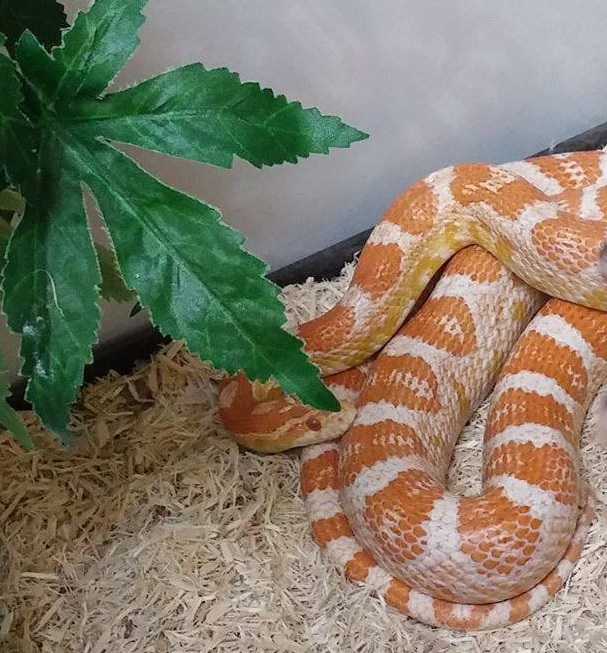
Housing:
a vivarium of at least 34" in length
Heating:
basking temperature of 90oF, cool end of 70-80oF
Diet:
carnivore with a diet comprising of frozen prey
Decoration:
dry substrates and decor so not to raise humidity levels
Housing:
The corn snake's vivarium should be at least 860mm (34") in length. There are 2 main reasons for this; firstly corn snakes are not small reptiles and can easily grow to 1200mm in length. They require a proportionate amount of space to live happily. Secondly, the vivarium needs to have a sufficient length to allow for the creation of a temperature gradient. The enclosure needs to be warm at one end, but have enough distance for the temperature to drop at the cool end.
Heating:
During the day, corn snakes require a warm basking area . This is achieved by using a clear spot bulb at one end of the vivarium. To accomplish the required basking temperature of 85oF- 90oF we use one 40w basking light in a 3ft enclosure. At night corn snakes require a slight drop in temperature and total darkness. The basking light should be switched off. A night time temperature of 80oF is created by using a heat mat. These radiate heat but produce no light. The heat mat should always be controlled by a good quality thermostat. The thermostat will automatically turn mat on at night when the temperature in the vivarium drops. Temperatures should be monitored daily using a thermometer.
Decoration:
Corn snakes are primarily found in eastern United States. This climate includes plenty of brush, wood, clay, and somewhat dry soil, which gives us a good idea on what to base corn snake substrate on. Keep in mind, however, that pine and cedar should always be avoided. Although it’s naturally found around the same areas as corn snakes, they let off strong fumes which cause respiratory issues in reptiles when enclosed in a small space.
The most frequently used substrates for corn snakes include aspen, coconut fiber, and cypress. All three of these bedding options allow for burrowing, aesthetics, and they can be mixed to create an even nicer substrate. For example, cypress and coconut fiber are frequently used together. Paper towel is a more sanitary, yet less visually appealing option, nor does it allow for any digging or burrowing, paper towel is usually the best option for baby snakes.
Whilst corn snakes are not an arboreal snakes, they do like to climb on top of things to survey their surroundings. The vivarium should be decorated with various pieces of wood to enable them to do this. The corn snake vivarium can be decorated with artificial plants for a more natural look. A hiding spot at each end of the enclosure will allow the snake to move freely and thermoregulate while feeling secure.
Feeding:
As hatchlings, corn snakes should be fed weekly on defrosted pinky mice, as the snake grows the food size should be increased until the snake is taking large mice or even jumbos. Adult (over two years old) corn snakes can be fed once every two weeks as they can become overweight if fed weekly.when they reach adulthood, we feed ASF or Rats sized to your snake; a bit bigger than the largest part of your snake. A water bowl large enough for the snake to get in to should be provided on the cool end of the enclosure, we recommend changing the water every two – three days unless soiled (sooner).
Social Structure:
Generally, corn snakes are best housed alone. Corn snakes may actually attempt to eat a cage mate that is smaller than they are. Many keepers opt to house their corn snakes individually, only introducing them together for mating.We here at SHP believe most of not all snakes kept in the home, should be housed individually for the safety and well-being of the animals.
Handling:
After you have brought a new snake home, allow it to eat successfully several times before regularly handling it. Don’t handle young snakes more than once a week or so. Make sure to wait at least 36 hours after feeding your snake before handing it – this allows the snake to digest the prey item properly with out regurgitations ( which could be lethal to your snake)! Corn snakes are generally very easy to handle, although very food motivated. We keep our snakes on a feeding schedule (same feeding day every week) and typically use a snake hook to remove them from the enclosure for handling. Corn snakes can live 10-20+ years in optimal conditions! Enjoy your new pet!
Please never release unwanted pets into the wild as most are unable to survive our harsh winters!Please contact SHP or a qualified exotic vet if you need to rehome your animal
*this care sheet is meant as a starter guide and not as a replacement for advice from you qualified exotic vet. We recommend yearly check ups to insure good health of your new pet.
Site by Bradley Hopkins @ SHP
